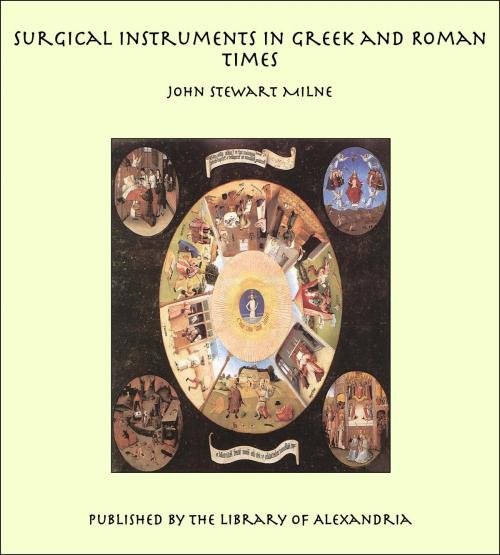Surgical Instruments in Greek and Roman Times
Nonfiction, Religion & Spirituality, New Age, History, Fiction & Literature| Author: | John Stewart Milne | ISBN: | 9781465543905 |
| Publisher: | Library of Alexandria | Publication: | March 8, 2015 |
| Imprint: | Language: | English |
| Author: | John Stewart Milne |
| ISBN: | 9781465543905 |
| Publisher: | Library of Alexandria |
| Publication: | March 8, 2015 |
| Imprint: | |
| Language: | English |
The object of this book is to lay before the student of medical history an account of the various instruments with which the ancient Greek and Roman surgeons prosecuted their craft. It is self-evident that no clear conception of a surgical operation, ancient or modern, can be formed from a written description without some previous knowledge of the instruments intended to be used. Many interesting operations described in detail in the classical authors are rendered obscure or quite unintelligible from lack of this knowledge. The learned Adams gives an accurate translation of a long and involved chapter by Paulus Aegineta on the use of the vaginal speculum, but remarks that owing to our want of knowledge of the specula possessed by the ancients the chapter is unintelligible. Daremberg says it is impossible to say what was the shape of any of the cutting instruments mentioned by Hippocrates. The steady progress of archaeological discovery has gradually added find after find of surgical instruments, till now there is scarcely a museum with any considerable number of antique petits bronzes which does not number among its contents a few surgical instruments, and in the Naples Museum alone there are hundreds. In several cases we know even the name of the original possessor of these and the special branch of surgery which he practised. There are thus open to us materials which were not available to the men of learning to whom I have referred above, and the time seems opportune to undertake a systematic review of all the materials at our disposal, and attempt to reconstruct the surgical armamentarium of the ancients. Considering the importance of the subject, it is surprising that no such systematic attempt has previously been made. Indeed, comparatively little attention has been given to this department of archaeology. Literature bearing on it is comparatively scarce.
The object of this book is to lay before the student of medical history an account of the various instruments with which the ancient Greek and Roman surgeons prosecuted their craft. It is self-evident that no clear conception of a surgical operation, ancient or modern, can be formed from a written description without some previous knowledge of the instruments intended to be used. Many interesting operations described in detail in the classical authors are rendered obscure or quite unintelligible from lack of this knowledge. The learned Adams gives an accurate translation of a long and involved chapter by Paulus Aegineta on the use of the vaginal speculum, but remarks that owing to our want of knowledge of the specula possessed by the ancients the chapter is unintelligible. Daremberg says it is impossible to say what was the shape of any of the cutting instruments mentioned by Hippocrates. The steady progress of archaeological discovery has gradually added find after find of surgical instruments, till now there is scarcely a museum with any considerable number of antique petits bronzes which does not number among its contents a few surgical instruments, and in the Naples Museum alone there are hundreds. In several cases we know even the name of the original possessor of these and the special branch of surgery which he practised. There are thus open to us materials which were not available to the men of learning to whom I have referred above, and the time seems opportune to undertake a systematic review of all the materials at our disposal, and attempt to reconstruct the surgical armamentarium of the ancients. Considering the importance of the subject, it is surprising that no such systematic attempt has previously been made. Indeed, comparatively little attention has been given to this department of archaeology. Literature bearing on it is comparatively scarce.















